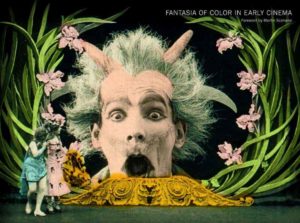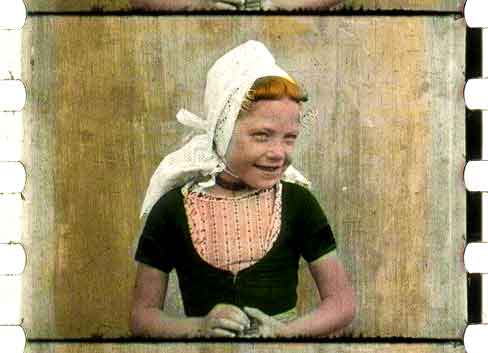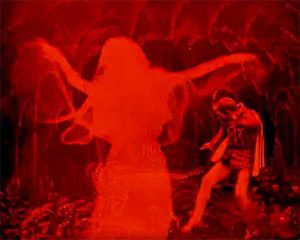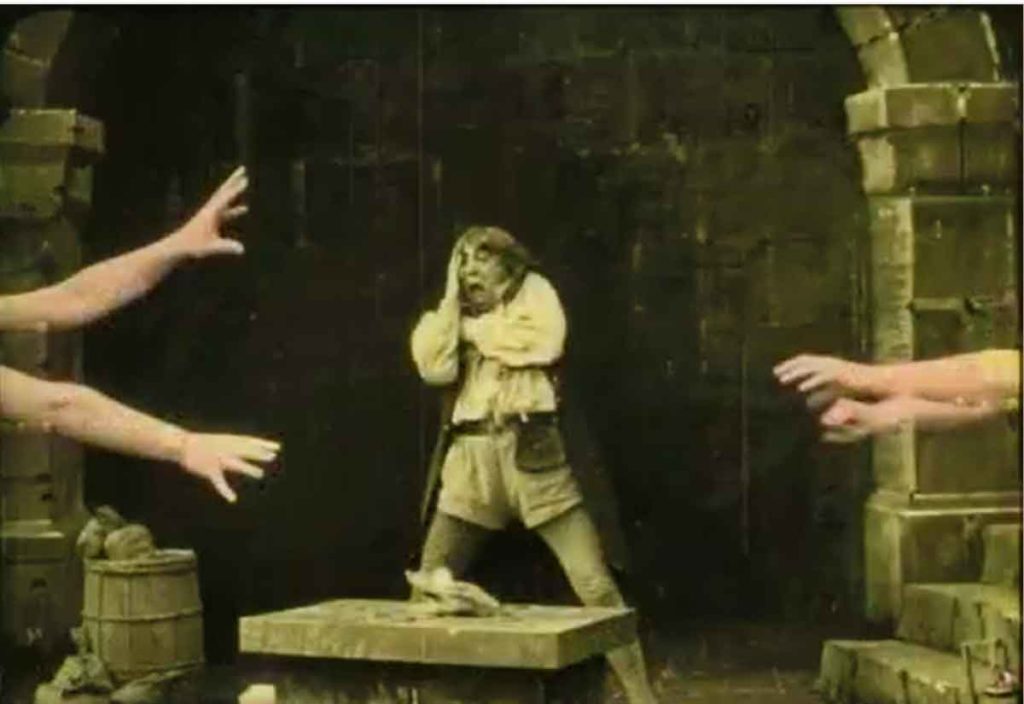 By TOM GUNNING, JOSHUA YUMIBE, GIOVANNA FOSSATI, JONATHAN ROSEN, MARTIN SCORSESE (Amsterdam University Press; 2015)
By TOM GUNNING, JOSHUA YUMIBE, GIOVANNA FOSSATI, JONATHAN ROSEN, MARTIN SCORSESE (Amsterdam University Press; 2015)
In the years since its initial publication this book, a strikingly designed coffee table hardcover, has become a legend among cinephiles. There’s a good reason for that, as FANTASIA OF COLOR IN EARLY CINEMA is a wholly unique and eye-popping pictorially oriented look at the silent movie era with a most unexpected emphasis: color.
FANTASIA OF COLOR IN EARLY CINEMA is a wholly unique and eye-popping pictorially oriented look at the silent movie era with a most unexpected emphasis: color.
Yes, color was an important component of the silent era. As this book’s main compiler, University of Chicago professor Tom Gunning, makes clear, the popular idea that color (as opposed to black and white) photography was only applied to film several decades after the format began is a severe misconception, as “color did play an important role in the first decades of cinema, indeed for most of the silent film era.”
This process was undertaken almost entirely by women (as they were believed to have greater handcrafting skills than men)…
 Included are several essays recounting the history of film coloring, which was initially accomplished by painstakingly applying paint, stencils and tints to each frame. This process was undertaken almost entirely by women (as they were believed to have greater handcrafting skills than men), and in its heyday took place in densely populated laboratories, the first film work, incidentally, to be made available to women. This text-based portion of the book, which takes up around 60 heavily illustrated pages, is a bit on the dry side, but can be skimmed without missing too many important details.
Included are several essays recounting the history of film coloring, which was initially accomplished by painstakingly applying paint, stencils and tints to each frame. This process was undertaken almost entirely by women (as they were believed to have greater handcrafting skills than men), and in its heyday took place in densely populated laboratories, the first film work, incidentally, to be made available to women. This text-based portion of the book, which takes up around 60 heavily illustrated pages, is a bit on the dry side, but can be skimmed without missing too many important details.
The book’s main and most vital portion consists, simply, of full-page stills from 63 silent films held by the Netherlands based EYE Film Institute. The line-up includes some fairly well-known titles, such as THE DREAM OF A RAREBIT FIEND (1906) and Georges Melies’ LEGEND OF RIP VAN WINKLE (1905), as well as a number of obscurities, such as EXCURSION DANS LA LUNE, a 1908 rip-off of Melies’ seminal TRIP TO THE MOON, and JAN KLAASSEN IN DE HELL (1915), which is “still waiting for better identification.”
In truth the origins or artistic qualities of these films are immaterial, as all the stills presented here are works of art. The scratching, fading and blurring haven’t been digitized away, giving these images, which run the gamut from the mundane (ducks frolicking in a pond) to the fantastic and surreal (a man terrorized by disembodied eyes) the feel of artifacts from some impossibly distant era—which is, in essence, exactly what they are.
…all the stills presented here are works of art.
Throughout, the spectator’s attention is drawn exactly where the book’s compilers intended: to the use of color, which in some images was dabbed on in spots (as in a black and white puppy bearing a strikingly pink tongue) and in others overlaid via tinting (a blue-tinged arctic landscape), while others were given the full spectrum (an elaborate stage-set procession that includes seemingly every conceivable hue).
“When we’re talking about the earliest color in cinema, we’re not even talking about a process, but an artisanal practice—a bridge between the homemade and the industrially produced.”
As Martin Scorsese states in his forward, “when we’re talking about the earliest color in cinema, we’re not even talking about a process, but an artisanal practice—a bridge between the homemade and the industrially produced.” Hence, this book stands as a valuable history lesson (even if one doesn’t bother reading the essays) as well as an irresistible piece of eye candy.


